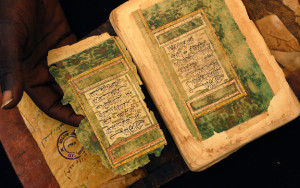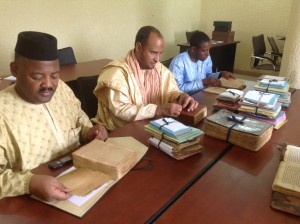 A few years ago I was hired at a large library and part of our orientation was a tour of all the departments within the library, called the Path of the Book. The point of the tour was to show how a book made it from selection to purchase to receiving and cataloging and finally onto our shelves. The tour also gave all staff at all levels the tools and knowledge to know where in the process a book might be and who to ask if we had any questions. I’ve been thinking a lot about this process in my work as CMO of T160K.org specifically our crowdfunding for the cataloging of the rescued Timbuktu manuscript collection. When planning to digitize and share an immensely valuable historic collection like this, each part of the process has to be fully funded in order to move onto the next step. Professionally trained local librarians and archivists must be compensated fairly and deferred to in the selection and cataloging process as well. You can’s skip ahead and still do justice to the collection as a whole, or the people on the ground running the project.
A few years ago I was hired at a large library and part of our orientation was a tour of all the departments within the library, called the Path of the Book. The point of the tour was to show how a book made it from selection to purchase to receiving and cataloging and finally onto our shelves. The tour also gave all staff at all levels the tools and knowledge to know where in the process a book might be and who to ask if we had any questions. I’ve been thinking a lot about this process in my work as CMO of T160K.org specifically our crowdfunding for the cataloging of the rescued Timbuktu manuscript collection. When planning to digitize and share an immensely valuable historic collection like this, each part of the process has to be fully funded in order to move onto the next step. Professionally trained local librarians and archivists must be compensated fairly and deferred to in the selection and cataloging process as well. You can’s skip ahead and still do justice to the collection as a whole, or the people on the ground running the project.
Why are the medieval manuscripts of Timbuktu so important anyway?
 “In 2012, under threat from fundamentalist rebels, a team of archivists, librarians, and couriers evacuated an irreplaceable trove of manuscripts from Timbuktu at great personal risk…The manuscripts of Timbuktu record hundreds of years of diplomacy, scholarship, and jurisprudence on (these) topics in great detail. Peacemaking and conflict resolution are a part of this region’s long history… The manuscripts currently reside in Mali, where they have resided for 700 or more years, and we believe they should remain there.” –Tony Dowler, T160K CEO
“In 2012, under threat from fundamentalist rebels, a team of archivists, librarians, and couriers evacuated an irreplaceable trove of manuscripts from Timbuktu at great personal risk…The manuscripts of Timbuktu record hundreds of years of diplomacy, scholarship, and jurisprudence on (these) topics in great detail. Peacemaking and conflict resolution are a part of this region’s long history… The manuscripts currently reside in Mali, where they have resided for 700 or more years, and we believe they should remain there.” –Tony Dowler, T160K CEO
*
So what is the Path of the Book when it comes to the medieval manuscripts of Timbuktu?
The path of the book is really the stages librarians in Mali and funders around the globe have gone through to save, preserve, describe and finally digitize this collection.
save, preserve, describe and finally digitize this collection.
“Efforts to digitize the manuscripts have been ongoing, but were interrupted by the violent uprising of 2012. The manuscripts are composed of extremely fragile papers and unstable ferrous inks which literally burn when exposed to traditional “hot light” scanning processes. A significant number of manuscripts have already been scanned using cold circuit photography. Complete digitizing of the manuscripts is one of our long-term dreams. Cataloging will help us move in that direction.” –Tony Dowler, T160K CEO
*
√ Step 1: Rescuing the Manuscripts (fully funded!)
DONE! It took an immense amount of bravery and foresight on the part of Dr. Abdul Kader Haidara and the other librarians on the ground in Mali, as well as the contributions of every single person who gave to the rescue efforts both their time and money, but it was a success. 400,000 manuscripts were rescued, all but 200 of them in total! Success!
The next step was ….
√ Step 2: Preserving the Manuscripts (fully funded!)
DONE! T160K was formed in the efforts to preserve the manuscripts. Mali is both geologically and weather-wise very diverse. Timbuktu, where the manuscripts have lived and been housed in family libraries for over 700 years is dry. DRY! Desert conditions were fantastic for preserving the velum, but when everything was moved to the safety of Bamako, the capital, the moist air threatened to destroy the manuscripts even so. T160K ran an IndieGoGo campaign, called Libraries In Exile, to fund preservation materials and archival boxes for the manuscripts. They raised over $60,000 in one month and the manuscripts were saved!
The next step was ….
Step 3: Cataloging the Manuscripts (needs funding!)
I wrote a blog post for the T160K blog called “How Do They Know What to Digitize First? Why cataloging is the KEY to digitization of the Mali Manuscript.” In the piece I lay out the reasons that cataloging is important in the digitization process, and this concept is something the readers of INALJ are probably already familiar with. Basically in order to determine which items to digitize first the digitizers must know what is in each manuscript. The manuscripts are in many different African languages as well as Arabic and cover topics from justice and the peace process to mathematics and agriculture. We are grateful to the trained catalogers on the ground in Mali, but what they need is funding!
The next step after this is ….
Step 4: Digitizing the Manuscripts (in process / once cataloging is funded!)
Several organizations have already begun this work, but they are also waiting to find out which items need digitizing first. This is why fully funding the cataloging project is VITAL! In order to move forward and digitize the manuscripts that are most likely to help the peace process in Mali be a success the cataloging needs to happen first!
The next step is ….back to #3 – fully funding the cataloging project. Having raised nearly $16,000 already and with a goal of $100,000, T160K and the Mamma Haidara Commemorative Library in Mali ask the global communities of librarians, archivists and other information professionals to give as little as $1 and to share the story of the manuscripts with their friends, families and networks. Rescuing and preserving the manuscripts took the efforts of many, and now to share these books they NEED our help! Consider sharing this on Facebook, Twitter, Tumblr, LinkedIn or any social media platforms! $5 is all it takes to catalog one manuscript, so know that any and all funds raised help immensely!
